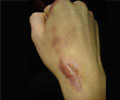Scientists at the Technion-Israel Institute of Technology have developed new nanofibers that could one day be used to heal wounds with minimal scarring and rejection by the immune system.
Scars and wound marks may soon become things of the past with the discovery of new nanofibers developed by scientists at the Technion-Israel Institute of Technology. Th nanofibers could be used in the future to heal wounds with minimal scarring and rejection by the immune system.
The strong, flexible, bio-material, is made from a common blood protein, and could be used to make the thin threads needed for wound sutures, larger dressings for wounds, and other anti-adhesion membranes used in abdominal surgeryTechnion researchers Eyal Zussman, Arie Admon and their colleagues claimed that the fibers, made entirely from biological material, with no synthetic additives, is more likely to integrate with the body's natural tissues and leave less of a scar, which could make it ideal for wound closure after Caesarean surgery or cosmetic procedures.
Dr. Miriam Rafailovich, a materials science and engineering research at the State University of New York at Stony Brook, said as the new material is not overly adhesive, it could thus be useful in treating burns.
"I see all kinds of applications for it where you don't want a dressing to stick to a wound," she said.
For the study, the researchers turned the globular protein bovine serum albumin into thick mats using electrospinning, a technique that uses an electrical charge to pull and stretch liquid droplets into nano-sized fibers.
As it has been a challenge to spin organic materials into stable threads, it was necessary to spin a blend of artificial and natural molecules.
Advertisement
Zussman explained that serum albumin "was selected under the assumption that, being one of the most abundant proteins in the body, nanofibers made from serum albumin would be regarded as being less foreign to the body and therefore less likely to be rejected."
Advertisement
Most proteins adopt a coiled shape, which scientists attempt to "straighten out" by adding artificial molecules to the protein during electrospinning.
Rafailovich explained: "What the Zussman group figured out-the ingenuity of what they did-was to find a way to break the protein's bonds and turn it into a linear polymer" without using additional molecules to force it into a fibrous shape.
Zussman said that the Technion researchers are planning to test their electrospinning technique on other proteins.
The study was published in the journal Biomacromolecules.
Source-ANI
TAN/M










